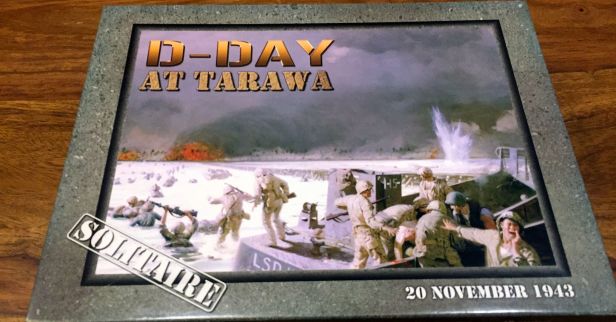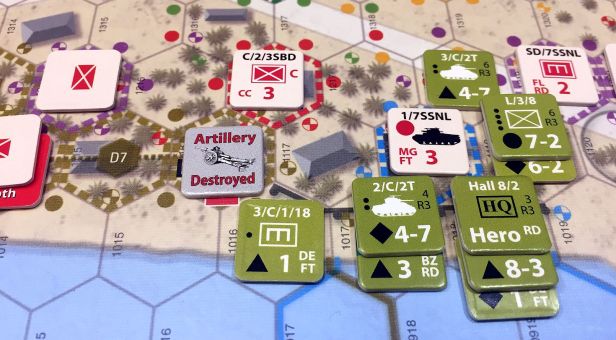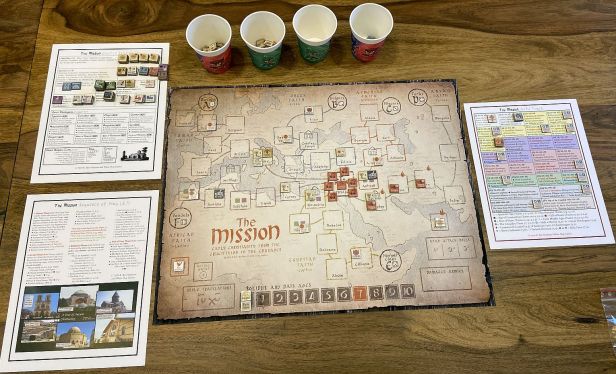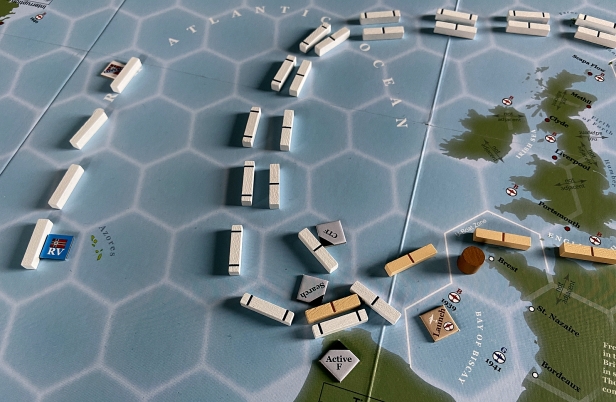This is second article describing my favorite solitaire wargames. In the first post I took liberty to present titles which usually had the solo mode as addition to multiplayer one. In the below text I focus on the positions solely designated for individual play, where multiplayer variant – if existing – is only an addition.
Except the three wargames which I already played extensively, there is also one which I am only started to discover, but it made such a great impression on me that I decided to put this in honorable mention (and it has its multiplayer and solo modes designed with similar care). So without further delay, let us go to the ranking!
Other articles in the series:
Pavlov’s House by DVG Games
Recently I started to eagerly discover games by DVG (Dan Verssen Games), with special interest on Valiant Defense series. The first game I got was Pavlov’s House and I immediately started to appreciate how well design it is.
In this title we take control of the brave defenders of a Soviet strongpoint in Stalingrad as they hold out against constant German attacks for almost two months. We also control the key leaders throughout the Soviet 62nd Army that made the defense of Pavlov’s House possible.
The goal in Pavlov’s House is to last through all the German attack waves, inflicting in the process as many casualties on attackers as possible. In the game, this is depicted by playing through a deck of cards representing elements of the German 6th Army.
One of the most ingenious design decisions was division of the map in three key sections, each having its own rules as well as cards deck and interacting with others:
- strategic perspective – on the right side of the board is a depiction of the Volga River and operational-level elements of the Soviet 62nd Army, which were critical in the defense of Pavlov’s House.
- tactical perspective – in the middle of the board is a view of the area immediately surrounding Pavlov’s House (primarily, 9 January Square). This portion of the board is used for tracking Wehrmacht Counters, as well as the deployment of Soviet Sappers in the defense of Pavlov’s House.
- operational perspective – on the left side of the board is a view inside of Pavlov’s House. The colored square areas are combat positions used by the Soviet Counters. This portion of the board is used for tactical-level movement of the Soviet Counters.
You may ask why I recommend it? First of all, Pavlov’s House is not an easy game to win. It is brutal & challenging and after each failure you just want to try once again. Secondly, and I would like to stress this – there is limited luck factor. You may smile to hear this – because you roll for many elements in game and draw cards. Still, the number of roll is enough to get the probabilistic results and definitely, there is no situation like “one roll ruins the whole game from the start”.
What I really appreciate and what makes me come-back to that game time and time again are Optional Rules. There are additional modes to play the game, like Operational Support or Tactical Cards. They can really enrich the game as well as make it much harder – your choice
Also, I love fantastic components – the board is thick and shiny, but when you sit next to is there are no reflections from the lights. The counters are solid and all those pictures of Russian soldiers – they simply make the game so real and not a academic exercise. The rulebook is also great as it guides you through all the important game mechanics and is printed on very good paper.
With the current situation in the world, I started to appreciate the solo designs much more then before pandemic. Pavlov’s House was a present for my birthday in March last year, just couple of days before first lockdown. And I am so glad I get it then 🙂
I cannot express enough how I like this design – the game is immersive, difficult, beautiful, re-playable, with various options and modes. You really have a feeling of being surrounded, lonely, with no way of escape, fighting sometimes almost with only bare teethe to stay alive. Strongly recommended!
So yes, this is definitely one of my top three in the category of solo games. Highly recommended!
More about game:
D-Day at Tarawa by Decision Games
As you probably can observe from my blog, I am devoted fan of John H. Butterfield creations. I focus on couple of titles like D-Day series or SpaceCorp. All those games are pretty procedural, with clear actions designed for the Artificial Intelligence (Bots). I really like the way cards drive the Competition / Germans / Japanese behaviours – you do not have to look up the possible actions in pretty complicated flowcharts. Still, be advised that – especially in case of D-Day – you will face enormously difficult task to deal with. Those titles and its scenarios really try to depict the hardships, misfortunes and difficulties of the landings. But believe me, the joy of achieving even smallest successes is great.
Some more info on game I have chosen for top 3. In D-Day at Tarawa you command the invading American forces against dug-in Japanese defenders, which are controlled by the game system. Tarawa covers the landings on Betio Island in November 1943, and the operations of the US 2nd Marine and 27th Infantry Divisions to clear it — the first heavily contested landing of the Pacific War. The battle for the tiny Island raged for four days and, when it was finally over, fewer than 200 of the 5,000 Japanese defenders remained alive.
Playing D-Dat at Tarawa is very enjoyable experience although do not expect easy wins. The game is tough, you need to be prepared to get a lot of casualties but in the end – once you are more familiar with the map – you see the path and possible axis of attack. The learning curve is painful but satisfaction even greater once you manage to achieve your goals!
What I find especially worth mentioning – and the reason why I put this before Omaha Beach – is Close Combat. This is very brutal but also thematic element of the Pacific Warfare and changes the whole dynamics of the series. Sometimes you even wish to sacrifice some units in order to crack otherwise un-penetrable defenses.
More about game:
The Mission by White Dog Games
Let me start with more details about the last game I have chosen for the Top 3 – I will help myself to great extent with the publisher description. The Mission: Early Christianity from the Crucifixion to the Crusades is a “grand strategy” solitaire game covering 1,200 years of Christian history on a map of the ancient Mediterranean, Near East, Europe and Africa. While the secular world of empires and politics plays out around you, your missionaries spread the Christian faith and convert areas of the map to your new religion. Each turn covers decades, and the flow of play will teach players about the expansion and doctrinal battles of early Christianity while you build institutions to educate, heal, and inspire the societies you touch.
So why I appreciate that game so much? Firth, the theme is very deep in this game. It goes through the narrative, mechanics, components, events. You really have a feeling that you travel in time and witness the onset and then development of Christianity. That really kept me interested through the whole session.
Still, in my opinion, the strongest feature of the game are the various epoch through which the games leads the player – from Apostles times, through Pagan and then Christian Roman empire, barbarians invasions, raise of Jihad and its transformation into Abbasid caliphate. Each of those plays completely differently – initially, you focus purely on faith, but with time the politics start to play more and more important role. The mechanics changes, the challenges too. This is why the game keeps you interested through as much as 27 turns! This is fantastic piece of design!
I will not give the game justice if I will not mention its components – I purchased the folio version due to obvious economic reasons. Still, the quality of tokens, map, rulebook or player’s aids is great and I had really great time with the game as far as visual side is concerned. The enlarged map (now a standard) also helps!
I really like this game – theme, components, epochs, mechanics. I am sure I will be playing more and have already other Ben Madison creations on my radar.
More about game:
Honorable mention
I could not restrain myself and avoid mentioning one of the newest releases which made such a great impression on me – Atlantic Chase. The game simulates the naval campaigns fought in the North Atlantic between the surface fleets of the Royal Navy and the Kriegsmarine between 1939 and 1942. It utilizes a system of trajectories to model the fog of war that bedeviled the commands during this period.
It has ingenious set of rulebooks / tutorials / solitaire and multiplayer scenarios. It is important to note that all 15 solo set-ups are grouped nicely into four mini-campaigns, each depicting separate period of war and also geographical location. Each has tailored table of enemy actions, which change as the game unfolds. A lot of effort was put here – instead “one system to fit all situations” we have dedicate bot manual for each separate scenario.
I hope to play this game more and share with Dear Readers my impressions. For now please find links to the Unboxing and Video Tutorial for first solo game.
Summary
In times we live in, the solitaire boardgames started to achieve much more prominent position then before pandemic times. They nicely fill the gap when it is simply impossible to meet with your friends and bring favorite titles to the table. They usually have great historical background and use some interesting systems to keep the gameplay interesting. I really appreciate the authors efforts in this matter.
And what are your favorite solo games? Please let me know in comments!














Hi, first may I say what a great resource, cheers!
My personal favourite solitaire wargame is the old original version of RAF by West End Games. A Butterfield classic that has been superseded by a glossy remake but I just love the original too much. I’ve added tons of chrome and extra rules to encompass the entire campaign and play it live day by day nearly every summer from July to October or usually beforehand when I am defeated by an inanimate card deck………For some its too repetitive but it works fine for me.
LikeLiked by 1 person
I heard so much good stuff about it that I might one day get it!
LikeLiked by 1 person
Charlemagne Master of Europe (Hollandspiele). Big Charlie has to move around the map, pacifying rebellions and defeating (and looting) barbarians. And also build cathedrals and roads and install marquis and deal with Saracens, Vikings and Byzantines.
LikeLiked by 1 person
I heard so much good about it that for sure I will need to get that title one day!
LikeLike